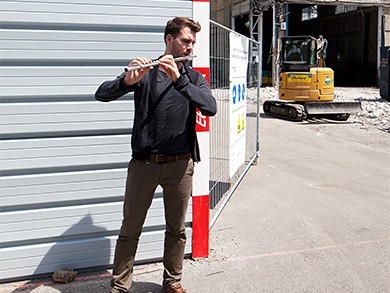Vlatka Horvat
Don't Stop, 2015

Tramgeräusche, Motoren und Stadtgemurmel mischen sich mit Musik. Wer kennt sie nicht, die Musikanten mit offenem Instrumentenkasten für den Passantenobolus, die uns mit ihren Melodien inmitten geschäftigen Treibens kurz aufhorchen lassen?
Die Stadt mit ihren temporären und einheimischen Bewohnern ist ein unübersichtliches Gemenge von zufälligen Gesten, von Überraschungen, von organisiertem Nebeneinander, von offenen Räumen, definierten Orten und verschiebbaren Grenzen. Solche Territorien und Grenzen gehören, wie die sozialen und strukturellen Beziehungen von -Individuum und Gesellschaft, von Körper und architektonischem Raum, zu den bevorzugten Themen von Vlatka Horvat (*1974, HR). Mit ihren konzeptuellen und minimalistischen Praktiken erforscht sie diese seit Beginn ihrer künstlerischen Tätigkeit. Dabei haben die daraus resultierenden Videoarbeiten, Fotografien, Installationen, Collagen, Objekte und Performances stets etwas spielerisch Humorvolles, aber auch etwas Verletzliches. In ihrer Offenheit und Durchlässigkeit wirken sie oft wie Momentaufnahmen, wie temporäre Szenerien, welche die Heterogenität eines spezifischen Raumes – verstanden als Überlagerung historischer, gegenwärtiger und zukünftiger Geschichten – sicht- und erfahrbar werden lassen.
Für AAA hat Vlatka Horvat die Baustelle am Schiffbauplatz ausgewählt. Mitten in einem polyvalenten Quartier mit seinem Prime Tower, der von grossstädtischem Flair zu träumen scheint, initiiert die Künstlerin einen Sommer lang eine Musikperformance. Immer zur selben Zeit, am Montagmorgen und Freitagabend, wird ein Musiker alleine Don’t stop thinking about tomorrow aufspielen. Oder müsste es eher heissen: er wird mit oder gegen das Feierabendgetriebe konzertieren? Und dies mit einem Song, der in den späten 1970er Jahren zu einem der erfolgreichsten Hits der Band Fleetwood Mac wurde und den Bill Clinton 1993 im Rahmen der Feierlichkeiten zu seiner Amtseinführung als Präsident live aufführen liess, sozusagen als Zukunftsversprechen. Als Endlos-Loop gespielt, ziehen die Töne vielleicht eher wie ein Stein, der ins Wasser fällt, in unserer Fantasie immer grösser werdende konzentrische Kreise; sie werden den Schiffbau mit seinem Theater einschliessen, den Escher-Wyss-Platz, die Hardbrücke ... Und inmitten grandios angedachter städtebaulicher Projekte und urbanistischer Transformationen, welche die Spuren globalisierter Kapitalflüsse in sich tragen, wird eine sisyphusartige, poetische Geste unvermittelt die nie gestillten Sehnsüchte nach einer besseren Zukunft immer und immer wieder heraufbeschwören und von der Verletzlichkeit und Fragilität des menschlichen Daseins erzählen. Elisabeth Gerber
Courtesy the artist und Galerie Annex 14, Zürich
Dank an Zürcher Hochschule der Künste (ZHdK)
English Version
Tram sounds, motors and the murmuring of the city combine with music. We are all familiar with them: musicians who cause us to briefly listen to their melodies in the midst of the hustle and bustle, their instrument cases open for donations from passers-by.
The city, with its temporary and native inhabitants, is a confusing mixture of random gestures, surprises, organised coexistence, public spaces, defined places and movable boundaries. In addition to such territories and boundaries, the social and structural relationships pertaining to the individual and society, as well as to the body and the architectural space, are among the themes preferred by Vlatka Horvat (b. 1974, Croatia). With her conceptual and minimalist practices, she has been exploring these ever since she started working as an artist. The resulting video works, photographs, installations, collages, objects and performances always have something playfully humorous about them, but also something vulnerable. In their openness and permeability, they often come across like snapshots, temporary scenarios that make it possible to see and experience the heterogeneity of a specific space, understood as the overlaying of historical, current and future stories.
For AAA, Vlatka Horvat has chosen the construction site at Schiffbauplatz. In the middle of a polyvalent neighbourhood, with its Prime Tower, which appears to dream of big-city flair, this artist is initiating a summer-long music performance. Always at the same time, Monday morning and Friday evening, a lone musician shall play the song Don’t Stop (Thinking About Tomorrow). Or should it instead be said that the musician shall perform with, or against, the Friday evening hurly-burly? This, with a song that became one of the most successful hits for the band Fleetwood Mac in the late 1970s, and which Bill Clinton arranged to have performed live during the celebrations of his presidential inauguration in 1993 – as a promise for the future, so to speak. Played as an endless loop, rather like a stone that falls into water, perhaps the sounds will draw ever-enlarging concentric circles in our imagination, encompassing the Schiffbau building with its theatre, the square Escher-Wyss Platz, the bridge Hardbrücke and so on … In the midst of grandiosely conceived urban development projects and urbanist transformations that invoke the never-satisfied desires for a better future, over and over again, telling of the vulnerability and fragility of human existence. Elisabeth Gerber
Courtesy of the artist and gallery annex14, Zurich
Thanks to the Zurich University of the Arts (ZHdK)